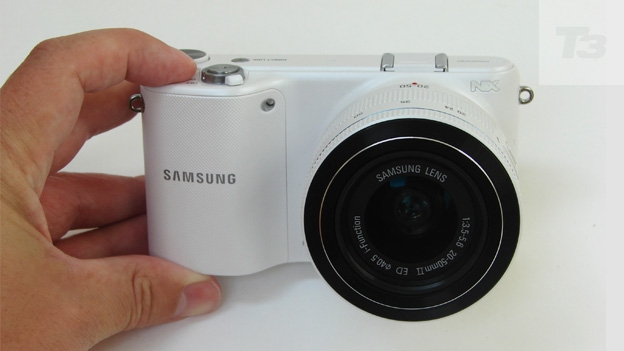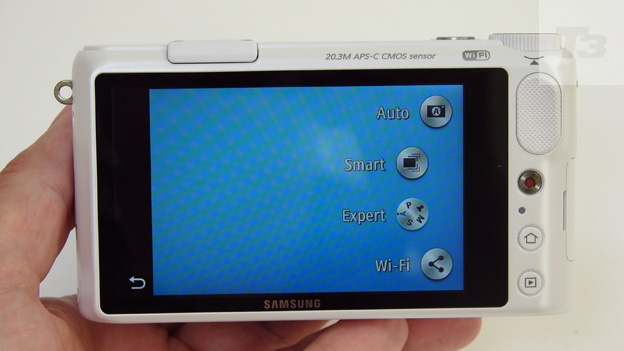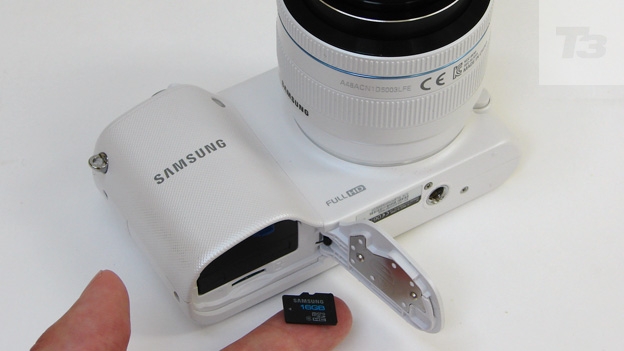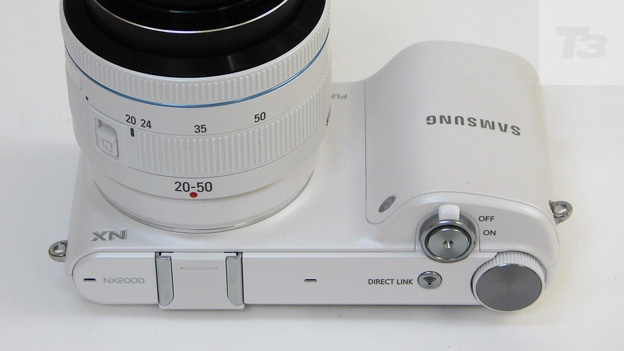Samsung NX2000 review
The Samsung NX2000 is a second-gen, Wi-Fi-equipped entry-level CSC


-
+
Larger touchscreen
-
+
Sharp colourful images
-
+
Plenty of detail
-
-
microSD card
-
-
No built-in viewfinder
-
-
No built-in flash
Why you can trust T3






The Samsung NX2000 adds NFC to Wi-Fi connectivity, updating 2012's NX1000, along with a larger touchscreen and at a lower price
Announced shortly before the potentially game changing Samsung Galaxy NX, the more traditional compact system Samsung NX2000 camera feels slightly overlooked in the hubbub.
It being an update of last summer's popular entry-level Samsung NX1000 - awarded four stars by us at the time - Samsung has avoided throwing the baby out with the bathwater and looks-wise nothing much has changed, from the front at least.
We still get a flat-fronted design alleviated only by the subtle curve of its handgrip, though the arctic white finish remains eye catching (and Samsung Galaxy Tab matching). Alternative body colours are pink or black this time around.
Inside we get the same APS-C sized sensor as the NX1000, not that we're complaining as the 20.3 megapixel resolution delivered some knockout results for a non-DSLR camera.
So what exactly is new? Well it's largely a case of refinements. The 3.7-inch back screen now affords touch-panel operation, swallowing up most of the rear plate, and maximum light sensitivity has been bumped up from ISO12800 to a more competitive ISO25600.
Samsung has also included a new operational feature in Best Face, a mode which shoots five consecutive shots and lets the user select their preferred facial expression.
While its forbear came with Wi-Fi connectivity, this iteration adds on NFC too - bringing it into line with new releases from rivals, such as the Panasonic G6 and Panasonic GF6, and allowing Samsung to suggest this camera is smart - and not just in its appearance.
Subtle tweaks aside the launch price with 20-50mmm compact zoom lens is also £100 less than the NX1000 initially was last year, at a penny under £500. Plus, as with the Samsung NX300, that's with Adobe Photoshop Lightroom 4 software bundled in the box.
If you're not crazy about the standard zoom, lens support currently comes in the shape of 12 own-brand alternatives, including a 45mm lens that allows switching between shooting in 2D and 3D, plus ultra compact fixed focal length 'pancake' lens.
So, while the above suggests more evolution than revolution - no bad thing as the NX1000 was pretty much ideal for its target market of smartphone upgraders - how does the Samsung NX2000 shape up in practice?
Samsung NX2000: Controls
Like the NX1000 before it, the NX2000 is a minimalist affair in terms of control layout and positioning, accentuated by the arctic white finish of our sample, plus the fact that a larger screen now swallows most of the rear.
Attendant buttons on the right-hand side of the LCD are limited. We get a red video record button, a familiar home button as found on its Samung Galaxy Camera (and obviously smarphones), plus image/video playback button.
Up on the top plate we have an unmarked control wheel that falls readily under the thumb of the right hand, and a forward positioned shutter release button encircled by on/off lever sitting atop the handgrip.
We also get a hotshoe for adding accessories - including the small clip-on flash included in the box that was also a feature of the NX1000. This obviously means that there's no body integral bulb, so you have to remember to slip it into a pocket if you think there might be the requirement of artificial illumination.
On the plus side, the omission of flash helps maintain a low camera profile and that minimalist appearance. Still, we'd rather have had a pop-up version included within the body, as on the higher-end Olympus E-P5 and Panasonic GX7.
Samsung NX2000: Screen
We're reliant on the one screen for composing and reviewing images on the NX2000, just as we were with the NX1000. A new generation device hasn't seen Samsung add a smaller electronic viewfinder; this is the starter model in the range after all.
As mentioned at the outse,t however, screen size has increased from the regular 3 inches to a more impressive 3.7 inches, and resolution has been upped accordingly.
We're now offered a gargantuan 1,152,000 dots, as opposed to the previous model's already respectable 921K dots. As we'd expect the LCD offers a 100% field of view for photo and video composition, so what you see is what you get.
Another obvious change to the LCD is that it's now an intuitive touch panel - thus bringing the operational aspects of this model more into line with its manufacturer's smartphones (such as the Samsung Galaxy S4), tablets and indeed the Samsung Galaxy Cameras.
As you'd expect operation is very intuitive - images scrolled through with a swipe of the finger or sections enlarged with a flick of forefinger and thumb in reverse pinch-stylee.
Like the Galaxy NX we also get a virtual shooting mode dial on screen, with auto and expert options, plus a means of adjusting the likes of aperture by spinning a virtual lens ring - which is very cool.
Visibility is also good, in terms of shot composition and review, even if it inevitably suffers in strong sunlight you can still make out enough of the icons and image itself to continue operation.
Samsung NX2000: Battery
Despite the addition of the touch screen display, battery performance is actually slightly better than that of 2012's NX1000; the NX2000 affording up to 340 shots when compared to its predecessor's 320 images from a full charge. Not that its forebear was any slouch in this department, in already bettering most in its entry-level class.
Again, as with its predecessor the NX2000's battery is charged in-camera, like with your smartphone, with a USB lead and USB enabled mains plug provided for the purpose of hooking it up.
Samsung NX2000: Picture quality
We get the same physical size sensor here as the NX1000, with an identical amount of pixels, coupled with exactly the same kit zoom lens.
Fair enough; 'if it ain't broke don't fix it' is the approach here. We remain less impressed with the patronage of the small and fiddly microSD media used to store the resultant images, but it's one means of getting the job done.
Though the maximum lens aperture of the kit zoom supplied with the NX2000 is a not so bright or fast f/3.5, it's still possible to achieve attractive shallow depth of field shots with this camera.
At maximum wideangle too, detail is maintained well into the corners and moreover pictures look as sharp as we'd imagine a camera with an APS-C sensor to deliver.
This being a Samsung we get lovely colours into the bargain, with the greens and blues of landscape shots looking particularly lush, even when the device has been left on the camera's own default settings.
There is some slight purple fringing between areas of high contrast, but it's mostly kept under wraps and not really noticeable unless you're enlarging portions of a shot to actively look for it.
As the zoom is manually operated here, you might want to practice a bit before shooting video. Still, this does avoid any motorised noise on the soundtrack, with stereo sound recording offered here. One touch video record also keeps things simple and once again colour and detail is fairly impressive from what is after all a starter model.
Samsung NX2000: Verdict
The Samsung NX2000 offers the same 20.3-megapixel effective resolution from an APS-C sensor as last year's NX1000 - but that's good news.
We also get a larger touch screen LCD, NFC connectivity, expanded ISO range topping out at ISO25600 and other less important operational tweaks.
While we'd wager that this is not enough to have existing NX1000s rushing to upgrade - after all, photo and video spec and quality is exactly the same thanks to an identical kit lens and sensor combo - anyone looking for an easy to grasp upgrade from (or in addition to) their Samsung smartphone will find much to savour here.
Samsung NX2000 release date: Out now
Samsung NX2000 price: £499
Get all the latest news, reviews, deals and buying guides on gorgeous tech, home and active products from the T3 experts

Gavin Stoker has been writing about photography and technology for the past 20 years. He currently edits the trade magazine British Photographic Industry News - BPI News for short - which is a member of TIPA, the international Technical Imaging Press Association.